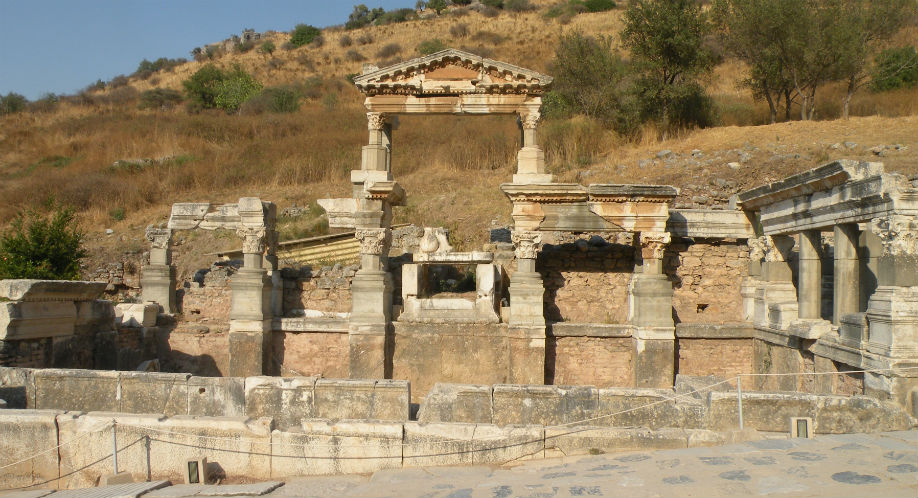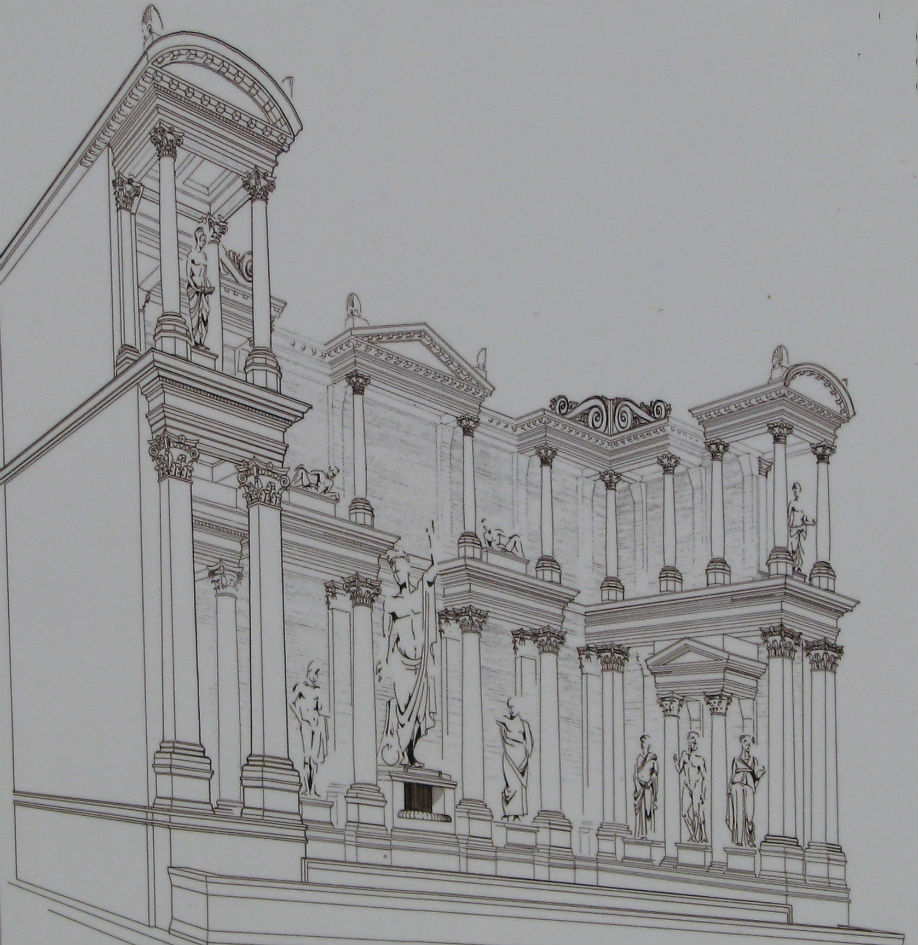The partially repaired fountain on the right side of the Curetes Street was dedicated to the Emperor Trajan at the beginning of the 2nd century AD. The dedicatory inscription is today on the cornice near the structure.
The fountain had two ornamental pools, in the front and rear,and two tiers of columns. The water flew from the big channel in the middle into the first pool. And on top of the channel there was a man-size statue of the emperor. The base and a part of a foot of the statue are in their original places. When the first pool was filled the water filled the pool in front. Those who needed would use it.
During the excavation of the building two statues of Dionysus, one in the nude and one clothed, and one statue of a Satyr in a lying position were found beside the statues belonging to the Trajan family. These statues are on display in the Ephesus Museum.

On the left of the Street of the Curetes beyond the Temple of Hadrian there was a two-storied building, a fountain bearing the name of the Roman Emperor Trajan.



This is one of my favorite spots on the walk through Ephesus. The fact we can view it is wonderful though I suppose a true archeologist would tell me the not yet excavated shops nearby matter more than an old monument. Another writer points out this is one of many stops on the long walk through ancient Ephesus.
This is another part of the Ephesus site. Basically you start at the top of the site and work your way down the hill. You will see all of these sites on your way.
What we were told when we saw Trajan's Fountain is that, while the archeologists had enough pieces to put together a representation of the building, which is what one sees right now, they have now found enough of the rest of the building that in years to come, they will completely reconstruct the Fountain.
Fountain of Trajan must have been impressive in its time. Another wonderful ruin as you walk down the path on the way to the Celsus Library which can be viewed from this spot.
Like it. It looks beautiful now, cannot imagine how it looked centuries ago. I found all Ephesus amazing.
it's hard to imagine what it used to be like bqack then, but you are already there, so… you have to take pictures and then, if you have the time, search it online so you can see what it used to look like.
The fountain provides another example of a well-preserved and reconstructed ruin. The signage and pictures help you understand what the fountain was used for, and probably looked like. Overall, the city has been beautifully reconstructed, and will amaze those who travel here.
This ancient fountain looks impressive but in reality had not been put together correctly during its restoration but hey! it still looks impressive.
Trajan's Fountain must have been impressive in its time. Another wonderful ruin as you walk down the path on the way to the Celsus Library which can be viewed from this spot.
Fountain of Trajan
The “Fountain of Trajan” in Ephesus has long been considered as one of the early examples of public fountain architecture in Roman Asia Minor that features a monumental aedicular façade. Discovered by the former excavation director Franz Miltner in 1957, this building is prominently located in the middle section of the Curetes Street in the city center. The importance of the Nymphaeum Traiani lies not in its function as a fountain. It rather represents a celebration of its benefactors Ti. Claudius Aristion and Iulia Lydia Laterane. The architectural form of this structure, especially its aedicular façade, is hardly necessary or suited for the withdrawal of drinking water. Instead, its architectural form provides an excellent venue for the purpose of self-representation of the Roman elite in Asia Minor. In short, the Nymphaeum Traiani is a monument that can be seen as a dedication to the honor of its donors and their contribution to the city of Ephesus as well as their ties to the Roman emperor.
A research project on the Fountain of Trajan was conducted at the Institute for Cultural History of Antiquity at Austrian Academy of Sciences, funded by the Austrian Science Fund (FWF, Projekt No. P 17617) from 2004 until 2007. The final publication in the series “Forschungen in Ephesos” represents the first detailed analysis of this structure, and with this new study, architectural questions and peculiarities posed by the earlier schematic reconstruction have now been resolved.